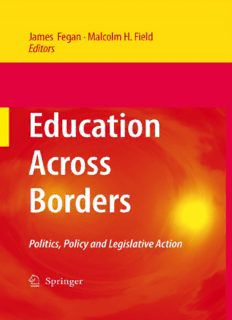
Education Across Borders: Politics, Policy and Legislative Action PDF
Preview Education Across Borders: Politics, Policy and Legislative Action
Education Across Borders · James Fegan Malcolm H. Field Editors Education Across Borders Politics, Policy and Legislative Action 123 Editors JamesFegan MalcolmH.Field ProfessorEmeritus Professor SchoolofInternationalLiberalStudies(SILS) FutureUniversity-Hakodate WasedaUniversity 116-2Kamedanakano 1-104Totsukamachi Hakodate,Hokkaido Shinjuku-ku 041-8655 Tokyo,169-8050 Japan Japan ISBN:978-1-4020-9410-1 e-ISBN:978-1-4020-9411-8 DOI10.1007/978-1-4020-9411-8 LibraryofCongressControlNumber:2008938162 (cid:2)c SpringerScience+BusinessMediaB.V.2009 Nopartofthisworkmaybereproduced,storedinaretrievalsystem,ortransmitted inanyformorbyanymeans,electronic,mechanical,photocopying,microfilming,recording orotherwise,withoutwrittenpermissionfromthePublisher,withtheexception ofanymaterialsuppliedspecificallyforthepurposeofbeingentered andexecutedonacomputersystem,forexclusiveusebythepurchaserofthework. Disclaimer:Theideasandopinionsexpressedinthefollowingchaptersarethoseoftheauthor(s)of the chapter in question and should not be interpreted as necessarily being those of any government, governmentalagencyorinstitutionwithwhichtheauthor(s)ofthechapterconcernedis/are,orhas/have been,associated. Printedonacid-freepaper 9 8 7 6 5 4 3 2 1 springer.com InMemoriam Anthony LloydEvansAdams† 26th September,1933–3rd September,2008 (http://memorialwebsites.legacy.com/ tonyadams/Homepage.aspx) Foreword The Universal Declaration of Human Rights endorsed in 1948 by member states oftheUnitedNationscontinuestoremainverymuchvalidasitprovidesthesolid foundationformostactionsandactivitiesthatareaimedatguaranteeingtherights ofeverybody.TherightsenunciatedintheDeclarationarecomprehensiveandtwo thatarerelevanttothecontentofthisbookaretherighttoeducationandtheright tolearn.Therighttoeducationandtherighttolearnareknowntohavebeenhotly debated by politicians, policy makers, and implementers. Sometimes, the rights in questionherehavefoundtheirwayintopoliticalparties’manifestoes,andadvocates oftherighttoeducationandtherighttolearnhavebeenquicktobringintojudgment politicians who have not lived up to their promises. Even at that, many member states of the United Nations have taken steps to ensure that access to learning is jealously guarded. For education and lifelong learning remain among the primary forcesthatcanguaranteeindividual,communityandnationaldevelopment,asthey hadalwaysbeenfromtimeimmemorial. Globally,therehasbeenampleevidenceofeffortsmadebygovernmentstopro- mote the widening of access to participation in learning activities. Even so, the literature on the subject of access and participation has not captured sufficiently what has happened across the world in terms of providing access outside national boundariesinthecontextofglobalizationandtherapidcreationoftheknowledge- basedeconomiesofthe21stcentury.Thisbook,entitledEducationAcrossBorders: Politics, Policy and Legislative Action, has come at the right time to fill some of the gaps existing in the global understanding and appreciation of the efforts being madetoextendeducationandlearningbeyondnationalborders.Thispresentbook provideswellresearchedinformationaboutcross-bordereducationandshouldhelp ussignificantlyinexploringwhatexistsandwhatisstillneededtoperfectprovision ofallkindsofeducationandlearningbeyondgeographiclimits. Thebookcouldbedescribedasuniqueinthesensethatithasexploredtheissues ofpolitics,policy,andlegislationastheyaffectdifferentaspectsofeducationpro- vision.Itcouldbesaidtobeevenmoreuniqueinthesensethatitsfocusistopical andsignificant.Itsscopeissuchthatitcoversissuesbuiltaroundhighereducation, politics and projects, impacts on national systems of education, scientific capacity building, support networks, and the interconnectedness between the international educationindustryandskillsmigrationprograms.Therangeofissuesisspecificbut vii viii Foreword broadatthesametime.Forexample,someofthecontributorshaveaddressedissues ofbilingualeducation,cross-culturaldelivery,transnationalteachermigration,path- waysininternationaleducation,andthetopicalelearningapproachtoprovision.In manymoreways,thisbookdrawsattentiontohowcross-bordereducationcanbest be provided and managed, from several perspectives, especially from the perspec- tives of the collaborative community of learners and the involvement of regional universities in enhancing the capacity and capability of nations to enter success- fully and negotiate their ways in the global markets together with the emerging knowledge-basedsocietiesofthe21stcentury. Theterm“acrossborders”itselfhasattractedmuchattentioninrecenttimes,and, rightlyso,becausetheeducationandtrainingoftheglobalworkforcecannotbethe prerogativeofjustafewnationsorasetofeducationalinstitutions.Furthermore,the global sharing of expertise has become the norm rather than exception, especially becausethemigrationofskilledlaboracrossbordersshouldatthesametimecompel ustoembracetheuniversalcultureofsharedexpertiseandresourcesinasefficient awayaspossible. Theconceptofcross-bordereducationisbenefitingusandshouldcontinuetodo sofromtheshoresoftherelatedconceptsofinternationalization,globalization,and overseaseducation,andithasbeenwellillustratedinthisbookthatallofthemhave been attracting various semantic values, depending upon the cultural, academic or political preferences to which one might give rein. This book has drawn sufficient attention to the differing dialogues on faculty, student, knowledge exchange, fees, structure, cyber differences and the various issues that complicate the mobility of globalknowledge,skills,attitudes,andvalues. The good news that this book brings, in the face of the complications and challenges, is that the proper design, management, and evaluation of cross-border educationcouldbreakdownallthebarriersthathavedelayedtheglobaluseofthis approach. In other words, the citizens of land-locked countries, as well as those who are restricted by one form of regulation, legislation, and policies or the other need not really have any fear that they cannot profit from the global cultivation of knowledge and skills needed for the maturing of a global economy. The common destinyofhumanbeingshasbeenaptlycateredforbythepromotionofcross-border educationandlearning. Thebeautyofcross-bordereducationisthattraditionalsojournersdonotreally need to traverse vast oceans or waters to “cross borders” in search of quality edu- cation and learning. This also has implications for the costs of learning. It brings down very considerably the huge expense always entailed in the physical skip- ping of borders in pursuit of knowledge. As already demonstrated in this book, cross-border education normally induces aspects of “internationalization”. Inter- nationalization itself infers that national and institutional vectors continue to play significant roles in the provision of education. So then, the internationalization of allsystemsandsectorsofeducationinvolvesintegratinginternational,intercultural, and global dimensions of education and learning into teaching, research, and the serviceanddeliveryofeducation. Foreword ix Understandingcross-bordereducationhasmeantthatpoliticians,policymakers, andpractitionersmustmakedeterminedeffortstoexpandthescopeofeducational provisions beyond their borders. The intention here is not to chase profits under the guise of an entrepreneurial approach to education. Rather, the intention must be that there is need to ensure that knowledge is equitably generated and cheaply shared among the comity of nations such that we can maintain and even improve on the levels and dimensions of global unity and progress. That I believe is the core message that this book brings to the fore. And this message has been fully andadequatelyaddressedbythecontributionsselectedfromacrosstheworld.That message has been enriched by the different theoretical and practical contributions thathavebeenmadebytheauthors.Thisbookdoesnotclaimtobethefinalword on the subject that it explores. What the book can claim as an added universal advantagearethecontributionsmadebyeminentscholarswhohavebeencarefully selectedfromalmostalltheregionsintheworld.Thereadershouldenjoytherich informationcontainedinthepagesofthisbookthathasbeenwritteninsimpleand easilyunderstoodlanguage,nomatterwhereyoucomefrominthiswideworldthat hasbeengravitatingmoretowardsbecomingonewithacommonfuture. Paris,2008 MichaelOmolewa Acknowledgments The Editors would like to express their thanks, first, to Ambassador Michael Omolewa of UNESCO and Dean Paul Snowden of the School of International Liberal Studies of Waseda University, for writing, in such a short time, prefatory and concluding overviews of the completed book’s coverage and aims. (Professor Snowden read several of the chapters, adding helpful editing annotations here and there; many thanks.) We also thank our knowledgeable and well-known team of authors – scholars and administrators drawn from a diversity of disciplines, and from, and with experience in, many parts of the world – for consenting to join us inputtingtogetherwhatweliketofeelis,asaresult,anobjectiveandauthoritative picture of Education Across Borders (principles, practices and perils) today – the goodandthenot-so-good,andofthepossibilities–dangersandopportunities–for ournewcentury. We,andtheauthors,wishtothankourpublisher,Springer,first,forseeingvalue intheproposalandforcontinuingassistanceandencouragement.TheEditorsthank, especially, Ms. Maria Jonckheere and Ms. Bernadette Ohmer, for always most promptly providing helpful information, and reassurance. Our thanks go, also, to Ms.LakshmiPraba,ProjectManager,IntegraSoftwareServices,forherdiligence, helpfulness–andpatience–oversomanymonths. Feganwouldlike,too,ashisSwansong,topaytributetohisco-Editor,colleague and friend, Malcolm Field, a committed teacher, educator, conference presenter, andpublishedscholar,forfirstproposingthepublicationofbothEducationAcross Borders volumes, for his consistent energy – and for his peripatetic conference- going (I am a stay-at-home, albeit thousands of miles therefrom) that helps him meet so many outstanding and influential men and women that he could assemble ateamofscholarsandadministratorslikethoserepresentedinthisvolume.Iwish himathirdandfurthervolumes,andallofyoucontinuedsuccess. xi Contents Introduction:CrossingBordersIsInevitableinHigherEducation ....... 1 MalcolmH.Field From Innocence to Experience: The Politics and Projects ofCross-BorderHigherEducation ................................... 19 JohnDaniel,AshaKanwarandStamenkaUvalic´-Trumbic´ Cross-BorderHigherEducationandNationalSystemsofEducation ..... 33 N.V.Varghese The Interconnection Between Australia’s International Education IndustryandItsSkilledMigrationPrograms.......................... 49 KumikoTsukamoto Scientific Capacity Building Across Borders inLatinAmerica:ACaseStudyonInclusion.......................... 61 LuisMiguelRomero ReflectionsontheCross-CulturalDeliveryofanInformationSystems DegreeinChina.................................................... 77 ChrisKeenandDeanSteer Elearning in European Higher Education: An Analysis of Present PracticeinIreland,Portugal,andtheUK,withLessonsfortheBologna Process............................................................ 93 BrynHolmes,IsabelHuet,DeniseLeahy,JohnGardner,DudleyDolanand Jose´ Tavares BorrowingIdeasAcrossBorders:LessonsfromtheAcademicAdvocacy of“Chinese-EnglishBilingualEducation”inChina ....................115 GuangweiHu xiii
Description: